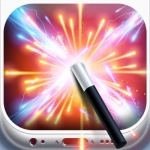
Muscle System Pro III
Medical and Education
App
** MASSIVE price reduction for a limited time only! ** DEVELOPED IN COLLABORATION WITH STANFORD...

Lullaby | AmbiScience™ Sleep Aid for Children
Medical and Health & Fitness
App
*** The Best Selling Line of Brainwave Apps on the Store - Since 2008. *** "...worthwhile set of...

Ding Top-up: Mobile Recharge
Utilities and Lifestyle
App
Recharge cell phones worldwide with Ding. Ding lets you send airtime to over 130 countries...

Magic Screen Pro - Customize your Lock & Home Screen Wallpaper for iPhone & iPod Touch (iOS8)
Lifestyle and Photo & Video
App
The #1 Wallpaper-making App is BACK for iOS 8 (version 3.5)! Back with more powerful features and...

Link! - Expanded Edition
Games and Entertainment
App
"Link" is a modern take on the classic 80's game. Build bridges using wood and steel girders, and in...

Heiner Muller After Shakespeare: Macbeth and Anatomy of Titus -- Fall of Rome
William Shakespeare, Carl Weber and Heiner Muller
Book
Heiner Muller After Shakespeare makes available for the first time Macbeth and Anatomy Titus Fall of...

The Adobe Photoshop CS6 Book for Digital Photographers
Book
ARE YOU READY FOR AN AMAZING NEW VERSION OF THE PHOTOSHOP BOOK THAT BREAKS ALL THE RULES? Scott...
Sarah (7800 KP) rated Rebecca (2020) in Movies
Nov 1, 2020
Rebecca as a novel is a classic and a book I very much enjoyed, and whilst I’ve never seen the Hitchcock adaptation, it’s often referred to as a fairly legendary classic too. However I’m afraid to say the same cannot be said about this new version. The basic plot and story is present, although rather frustratingly the ending has been extended unnecessarily, but it has not been executed very well.
The trailer made this look quite sinister and spooky, which is quite right when the original novel is a gothic horror with aspects of a ghost story thrown in. However this film turns out to be nothing of the sort. It’s more of a romantic drama with a hint of thriller thrown in – the gothic horror ghost story is nowhere to be seen and neither is any form of intrigue or suspense. In fact I’d be so bold as to say this is just outright dull, and even the campy over the top sinister vibes from Kristin Scott Thomas’s housekeeper Mrs Danvers are laughable at best. The most interesting part of this was the opening scene with it’s sinister score but this just didn’t carry through to the rest of the film.
Sadly the cast don’t fare very well in this either. Lily James is a great actor, but her version of the new wife is too mousy and timid and you wonder what on earth Maxim ever sees in her. The character herself is very frustrating and irksome as she’s far too naïve and sweet. And Armie Hammer is miscast as Maxim De Winter himself. He looks the part, dashing and handsome, but he’s lacking in the intrigue, charm and secrecy that you’d expect this character to have. He’s also missing the age gap that is rather notable in the book.
The cinematography in this is rather concerning. The scenes in Monte Carlo are far too colourful and garish and they just look out of place, even more so for something that is meant to be a gothic horror. I’m unsure of why this has been done, other than to show a striking difference between Monte Carlo and Maxim’s Cornish home of Manderley. In fact what is most concerning about this film is why Ben Wheatley wanted to direct it. By far the biggest shock of this film was finding out Wheatley, of Kill List and Sightseers fame, had directed it. Wheatley is known for psychological dark (and often funny) thrillers and there is nothing of his style to be seen in this film at all. Which is a shame, as I think a little more of his dark style would’ve propelled this film into more than just a sub-par drama.
Overall this a very disappointing and long winded adaptation of a classic novel. Whilst there are a few decent scenes and a good, if not out of character, performance from Lily James, these are nowhere near enough to save this from being a bit of a bore.
Bob Mann (459 KP) rated Honest Thief (2020) in Movies
Dec 3, 2020
The nice concept behind the story sees Tom (Liam Neeson) as a hugely successful bank robber meeting the love of his life in Annie (Kate Walsh) and committing to jack it all in for love. Furthermore, not wishing to have to live with the deception and guilt of his hidden life, he determines to hand himself over to the FBI, along with the $9 million stolen cash, in return for a lenient sentence.
There's a problem though: he's about the fifteenth person calling the FBI claiming to be the "In and Out burgler", so no-one wants to take him seriously. Boston area chief Sam Baker (Robert Patrick - the "Terminator" cop!) and his deputy Meyers (Jeffrey Donovan) casually put it on the "to-do" pile of agents Nivens (Jai Courtney) and Hall (Anthony Ramos).
The best laid plans run off the rails in a big way though when Nivens and Hall investigate and find that Tom is the real deal.
The concept here works nicely for a thriller, but the rest of the script is so formulaic that it's fairly and squarely a 'park your brain in the foyer' movie. For several of the actions and motives going on here, suspension of disbelief was required . Even given the limited competition in 2020, the script is in no way going to trouble the Academy.
All that being said, Mark Williams has put together a tight and well-executed movie, not outstaying its welcome at only 99 minutes long. Even with the 15 year age difference, Neeson and Walsh make a believable couple (given that Neeson looks pretty good for his 68 years) and the chemistry between them is great. And for a pretty 'small' movie, the supporting cast is pretty impressive.
Another standout for me was the cinematography by Shelly Johnson (whose had a busy year with the latest "Bill and Ted" and "Greyhound" under his belt). Boston - always a great movie location - looks spectacular, and the framing of the car chase action impressed me.
For me, there was only one really dodgy element of the movie: the special effects used in a house explosion/fire. The budget clearly didn't stretch to using practical effects! More work on Adobe "After Effects" (or similar) was required here!
Is Honest Thief worth seeing? - My expectations for this movie were pretty low. But I'm pleased to say that they were exceeded. Is it a masterpiece? No. Will I readily remember much about it in six month's time? No. But in rather a desert of new releases, this one was at least entertaining and I think it's worth the ticket price for a long overdue night out at the flicks. I'm willing to guess that my feelings were partially influenced by the sheer joy of being back in a cinema again... so I will temper my rating perhaps by a star here.
(For the full graphical review, please check out One Mann's Movies here - https://rb.gy/9kcnr5. Thanks.)

Accountant for iPad Calculator
Finance and Business
App
Accountant for iPad is the perfect calculator for general everyday use. Use it for adding columns of...

